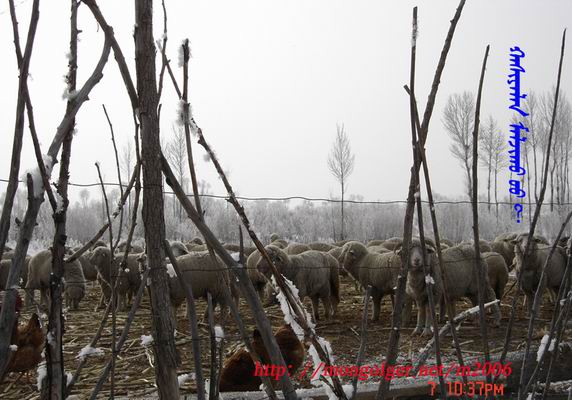 |
|
|
Photo of
www.mongolger.net
|
This year, livestock fencing is carried out from April 1 to July 1 in our Hushuu (county level administrative unit). Despite the fact that during the spring season livestock become physically active and herders experience severe foraging shortages, the authorities have tightened their “livestock fencing” policy, deployed the so-called “Livestock Grazing Prohibition Taskforces” (Jin Mu Dui in Chinese) and dispatched personnel and huge trucks with metal fences to hunt for livestock openly grazing on the grasslands. The Government’s “livestock fencing” policy is completely irrational and ignores the hardships being imposed on us and our livestock. Taskforce personnel are sent out in the morning and their trucks come back full of cattle, sheep, and goats that are then sent directly to the slaughter houses. The drivers and the Taskforce officers remind us of the olden-day hunters who triumphantly would come back with their game carcasses, and celebrate their success with wine and vodka in restaurants.
Our traditional pastoral way of life has flourished for thousand of years in this land. Why is it that this fertile land has turned to desert “due to the livestock grazing” only since recently but not during the past thousands of years? Government propaganda states that even developed rich countries in the west are adopting “livestock fencing” policies. We doubt that all developed countries stopped grazing livestock on open ranges and adopted livestock fencing. We heard that Australia, New Zealand, and Denmark are still practicing free livestock grazing. We understand that some developed countries with little land and crowded population are practicing livestock fencing but only with huge financial support from their respective governments due to the high cost of livestock fencing. However, in our case, the Government not only refuses to provide a single penny to us but also through the enforcement of the “livestock fencing” policy has imposed additional hardships on us pushing us into extreme poverty. A professor from the Inner Mongolian University of Agriculture and Animal Husbandry who was sent to promote the “livestock fencing” policy failed to give a reasonable answer to our question:
A herder’s household with 20 cattle, 40 sheep and 3-room house is considered a moderate level household. If you enforce “livestock fencing” to this household, at least a 5-room barn and 20 truck loads of hay and fodder are needed. This cost alone exceeds today’s market value of 20 cattle plus 40 sheep. With this simple math, do you think we will get rich or go bankrupt?”
A Russian scholar sarcastically said that “the Russians were enjoying a happy life thanks to the poor implementation of bad policies”. The opposite is true in our case: bad policies are effectively implemented and good policies are poorly implemented here. Livestock fencing might be suitable for those developed countries where there is more population and less grazing land. Due to its high cost and low return, livestock fencing is a potential alternative only if the government provides sufficient stipends to the herdsmen. However, in our case, a poor stipend and low income are forcing us to abandon our traditional way of life and adopt an urban one. It is extremely outrageous and burdensome that the Livestock Grazing Prohibition Taskforce is constantly raiding and confiscating our livestock without appropriate compensation. As a matter of practical impact, this policy has sacrificed the legitimate interests of the herders and has benefited only those who are implementing the policy.
Previously there was another government body called “Livestock Inventory Brigade” which regularly came to every herder’s household to carry out livestock inventory for the purpose of imposing heavy taxes on each and every head of livestock. Any livestock not reported and inventoried was confiscated and the owner was fined. Plundering herders’ livestock through some sort of flawed legal procedure today is no different from what the olden day thugs and hooligans did.
For our pastoral area and the entire grassland at large, the essential pre-condition for protecting the ecosystem is to maintain the balance among land, animals and humans. It is evident that the root cause of grassland degradation and environmental damage is the government’s flawed policies. In 1947, the total population was only 2 million in Southern Mongolia. Now it is more than 12 times that, far exceeding the maximum population capacity of our land and local resources. Waves of Chinese immigration have almost depleted our land and natural resources, and grazing lands have been turned to farmlands. Pushed by population pressure, Mongolian herders had no choice but to move to the less crowded barren lands. During the so-called “Great Leap Forward” in the 1950s and 60s and waves of national agricultural projects, our best pieces of grasslands were turned to farmlands; during the 1990s, even non-arable lands were cultivated anyway further exacerbating the desertification process. Isn’t it another flawed policy to blame all these on the so-called “over-grazing”, scapegoating our livestock practices to justify banning our pastoral way of life?
Recently, the Government initiated a project called “Ecological Migration” aiming to completely eradicate our way of life. Our houses and infrastructures have been demolished and we have been forcibly displaced to lines of match-box like mud houses built next to each other. We have no place to build our barns and store our fodder. We have no means to make livings, and are barred from returning to our land because our homes and infrastructure have been destroyed. We are totally helpless now. The policy makers are all from an agricultural background and their mentality is completely directed towards intensive farming and a sedentary way of life. Therefore, their bias is to blame us and the so-called “over-grazing”. This is even influencing and forcing some of our fellow Mongolian cadres to move to the side of “livestock fencing”.
May god bless our injured land and helpless herders.
Mongolian herders from Ongniud Hushuu, Southern Mongolia







